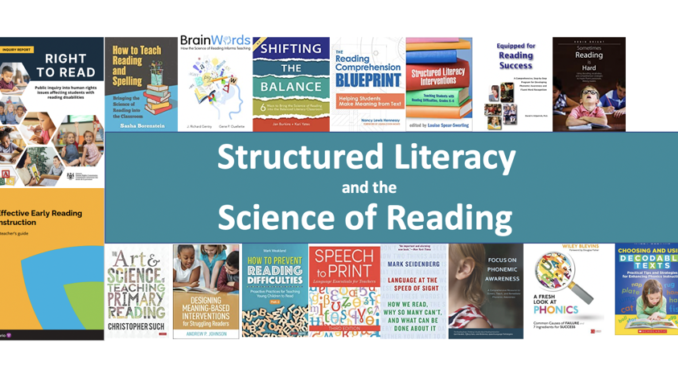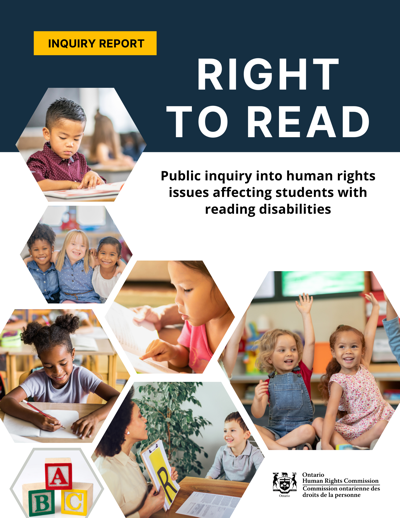
By Judy Ameline, Judy Chyung, and Emily Thompson
The Ontario Human Rights Commission’s (OHRC) recently released Right to Read inquiry report has sparked a surge in information requests on Structured Reading and the Science of Reading. This CSLJ list presents current readings on this aspect of the much broader topic of literacy learning. We have not attempted to capture the range of responses to the report itself, or presented the case for or against different teaching approaches – that would be another very long list, but you may wish to begin with these few:
- Response to Right to Read report. Ontario Library Association/Ontario School Library Association/Canadian School Libraries.
- Cummins, J. (2022). Ontario Human Rights Commission Right to Read Report: Sincere, passionate, flawed. Journal of Teaching and Learning, 16(1), 85-92.
- Response to the Ontario Human Rights Commission’s Right to Read Inquiry Report. Western University Centre for the Science of Learning.
This list on Structured Literacy and the Science of Reading was curated by Librarians at the TDSB Professional Library in the Library Learning Resources and Global Education Department of the Toronto District School Board. Links to TDSB Professional Library Catalogue records have been provided, however, items are available for loan or licensed online access to TDSB staff only.

Blevins, W. M. (2021). Choosing and using decodable texts: Practical tips and strategies for enhancing phonics instruction. New York: Scholastic.
Blevins explains why quality decodable texts are an essential early learning tool and how to distinguish the good from the bad. In addition to tips on choosing strong decodable texts and suggestions for what to do if there are none available, this resource offers practical lessons and routines for building children’s phonics and fluency skills. Includes fun and engaging reproducible decodable mini-books.

Blevins, W. (2016). A fresh look at phonics, grades K-2: Common causes of failure and 7 ingredients for success. Thousand Oaks, CA: Corwin Press. (eBook)
Using data collected over twenty years the author outlines which approaches to reading instruction truly work, which have failed, and how teachers can refine their daily instruction to improve student achievement.
Readers will learn seven aspects of phonics teaching that produce significant student learning gains— readiness skills, scope and sequence, blending, dictation, word awareness, high frequency words, and reading connected texts. This resource also provides:
- Activities, routines, word lists, and lessons that develop solid foundations for reading
- Ideas for differentiation, ELL, and advanced learners to ensure adequate progress for all learners
- Help on decodable texts, what not to over-do, and what you can’t do enough of for your students’ achievement
- Interactive activities that facilitate teacher self-reflection and school wide professional learning

Borenstein, S. (2021). How to teach reading and spelling: Bringing the science of reading into the classroom. Ashland, OR: Science of Reading Press.
The purpose of this resource is to actively guide educators and parents to teach the skills that are the basis for reading and spelling:
- Phonology – the sounds that make up the English language and phonological processing
- Orthography – spelling patterns
- Morphology – meanings of prefixes, suffixes and root syllables
- Etymology – the origins of English words
This book has been designed to provide educators with words to teach each concept, questions that will encourage students to actively reflect, and activities to help students spell and read words. Teachers will also learn how to correct student’s mistakes, nurturing their progress as independent readers and writers.

Bright, R. (2021). Sometimes reading is hard: Using decoding, vocabulary, and comprehension strategies to inspire fluent, passionate, lifelong readers. Markham: Pembroke. (eBook)
Sometimes Reading is Hard shows teachers how to develop the skills students require to be successful readers. This resource provides best practices and step-by-step activities to illustrate how teachers can integrate teaching the skills of reading, decoding, vocabulary, comprehension, and fluency with real reasons to read. As students improve their reading skills, their desire to read and their enjoyment of it, increase also, further motivating them and fostering a lifelong love of reading.

Burkins, J. M., & Yates, K. (2021). Shifting the balance: 6 ways to bring the science of reading into the balanced literacy classroom. Portsmouth, NH: Stenhouse. (eBook)
This resource offers readers a practical guide to making decisions about beginning reading instruction. While honoring the balanced literacy perspective, the authors describe common practices needing reconsideration or revision, keeping in mind the best interests of the students.
Each chapter:
- identifies an instructional practice to reconsider
- explores misunderstandings that establish and keep that practice in use
- shares scientific research to support its reconsideration
- proposes an instructional shift to apply a new perspective, and
- describes high-leverage instructional routines to support implementation of that shift.
Remarking upon gaps and overlaps as well as common misunderstandings and missed opportunities between the competing lines of thought, the authors provide educators with the means to integrate science and balance into their reading instruction, while prioritizing meaningful experiences with text.

Gentry, R., & Ouellette, G. (2019). Brain words: How the science of reading informs teaching. Portsmouth, NH: Stenhouse. (eBook)
The authors point to the new research on reading that shows how having a deep knowledge of words is critical to learning to read and building a dictionary of brain words. In the book, brain words are defined as stored representations of spelling patterns, syllables, and words. The authors explain that the brain words are key to developing fluid reading, and spelling leads directly to greater storage of orthographic representations or brain words. The book shows how to incorporate spelling and word study into effective reading instructions.

Hackett, A. (2021). Focus on phonemic awareness: A comprehensive resource to screen, teach and remediate phonemic awareness. Ontario: Independently Published.
This book is written by speech pathologists for educators to screen, teach, and remediate phonemic awareness, which they describe as the ability to isolate and manipulate individual speech sounds in spoken words, with a group or individual students. In the book, wordlists are provided for segmenting sounds of the words to make it easier for educators and parents to work with the students. The authors state that phonemic awareness is a critical component of the reading circuit, and this program is meant to be used alongside and integrated with strong phonics teaching.

Hennessy, N. L. (2021). The reading comprehension blueprint: Helping students make meaning from text. Baltimore: Brookes Pub. (eBook)
This book is written to provide educators on how to deliver well structured and highly effective comprehension instruction in their classrooms. Divided into three sections, the book describes the fundamentals of reading comprehension, a complete framework for organizing instruction that incorporates the science of reading comprehension, and practical guidance and tools for planning units and lessons in the classroom.

Johnson, A. P. (2021). Designing meaning-based interventions for struggling readers. New York: The Guilford Press. (eBook)
This book describes how to design and implement meaning-based interventions for struggling readers. The author starts by defining meaning-based intervention as “a reading intervention that seeks to keep the language used in literacy learning whole, complete, and meaningful” to help students create meaning with print. With that in mind, the author presents a variety of research-based strategies that address the reading-deficit areas in word identification, fluency, and comprehension for designing effective reading interventions. The book offers guidance and tools to assess reading problems and strategies to monitor student progress to meet the needs of individual students.

Kilpatrick, D. A. (2016). Equipped for reading success: A comprehensive, step-by-step program for developing phoneme awareness and fluent word recognition. Syracuse, NY: Casey & Kirsch Publishers.
This book provides a practical resource that bridges the gap between the reading research, particularly the findings that phonological awareness is a key element in the process of developing word recognition skills, and the classroom instruction to help the struggling readers. It is a practical guide to implement a step-by-step program in phonemic awareness as part of a comprehensive literacy program.

Moats, L. C. (2020). Speech to print: Language essentials for teachers. Baltimore: Brookes Pub. (eBook).
This book aims to make language concepts–such as phonetics, phonology, semantics, and syntax–more accessible, so teachers can better understand students’ needs as they learn to read, write, and spell. Without getting caught up in the technical aspects of linguistics, this book strives to help teachers understand the connections between language structure and how students learn to read. Includes chapter exercises, self-tests, and sample lesson plans.

Ontario Ministry of Education (2022). Effective early reading instruction: A teacher’s guide. Toronto: Queen’s Printer for Ontario.
This guide is intended to support teachers’ ongoing efforts to build student’s reading skills. It provides teachers with information on foundational early reading skills, an understanding of how these skills develop in children, and examples of evidence-based systematic and explicit instructional strategies to support students to become proficient and fluent readers.

Seidenberg, M.S. (2017). Language at the speed of sight: How we read, why so many can’t, and what can be done about it. New York: Basic Books.
In this book, cognitive scientist Mark Seidenberg examines the science of reading across various dimensions including cognitive science, neurobiology, and linguistics. The author takes a critical view of the disconnect between science and education, arguing that the failure to teach basic print skills places children at risk of failure, discrimination, and discouragement. By building on scientific insight, Seidenberg argues we can improve how children learn to read, and take better steps to prevent functional illiteracy.

Spear-Swerling, L., (Ed.). (2022). Structured literacy interventions: Teaching students with reading difficulties, grades K-6. New York: The Guilford Press. (eBook)
Structured Literacy refers to a wide range of interventions that are highly effective for supporting struggling readers, with a focus on explicit, systematic, and sequential instruction. Structured literacy approaches cover foundational literacy skills (such as phonics and spelling) as well as higher-level skills such as reading comprehension and written expression. Comprehensive and evidence-based, this book gives strategies to help teachers design and deliver structured literacy interventions for at-risk readers and students with reading difficulties. Chapters cover phonemic awareness, word recognition, spelling, reading fluency, vocabulary, oral language comprehension, and written expression.

Such, C. (2021). The art & science of teaching primary reading. Thousand Oaks, CA: Corwin Press.
Christopher Such is a primary school teacher and education blogger from Peterborough, England. In his book, he explores the technicalities and practicalities of teaching children how to read, with an emphasis on research-based ideas and classroom practices built on a strong understanding of how children learn to read. The book is divided into six parts: Reading and Its Origins, Decoding (with chapters on phonics and fluency), Language Comprehension, Opportunities to Enhance Reading, Addressing Reading Difficulties, and The Reading Diet (including action plans for classroom teachers and reading coordinators).

Weakland, M. (2021). How to prevent reading difficulties, grades preK-3: Proactive practices for teaching young children to read. Thousand Oaks, CA: Corwin Press. (eBook)
This book aims to help teachers better understand the science of reading in order to more effectively teach foundational reading skills to students in PreK to Grade 3. Clear, practical explanations of the science of reading give insight as to how reading arises in the brain, how difficulties arise, and how teachers can address those difficulties. Includes step-by-step techniques for teaching phonological awareness, spelling, phonics, vocabulary, and reading comprehension. QR codes throughout the book link to videos and online resources. Appendices include sample classroom reading schedules, letter-sound grids, word ladders and word banks.

Judy Ameline is a librarian at the Toronto District School Board Professional Library with almost 30 years experience providing reference service. She is passionate about providing TDSB teachers and leaders access to current, cutting edge information in the field of education to support their professional development needs. Check out the Library’s Pinterest Boards and follow her on Twitter @AmelineJudy

Judy Chyung has extensive experience providing Education Reference and Online Services to the educators and leaders of Toronto District School Board at the TDSB Professional Library. She enjoys reading and learning about the trends in education literature, and assisting TDSB educators with their information needs whether for their classroom support or for their professional learning. One of the initiatives that she leads is the curated Resource Guides for Heritage Months celebrated by TDSB. You can check out the Guides at http://bit.ly/DirectoryHeritageMonthListsPL. Currently she is deeply involved in developing Subject Guides to support TDSB educators and students with their curriculum resource needs. These Subject Guides can be found in the TDSB Virtual Library under the FIND tab.

Emily Thompson is a Reference and Digital Resources Librarian with the Toronto District School Board Professional Library. Prior to joining the TDSB this year, she spent nearly a decade in public librarianship and is passionate about early literacy. She is excited to be a part of the TDSB Professional Library team, connecting users of all ages with digital resources through the Virtual Library. Follow the TDSB Virtual Library on Twitter: @tdsbVL
